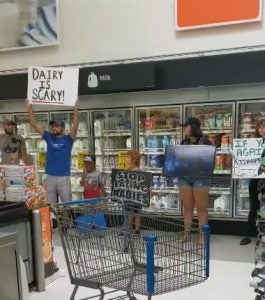Why is it that animal agriculture gets the brunt of rising food-centered activism? Is it that animal agriculture is truly horrid and we’ve all just been blind to it for so long? (News flash, that isn’t the case!) Or is it that animal industries are just easy targets?
Fifty years ago, you didn’t see activism against animal agriculture as much, and each year the campaigns appear to have gotten wider and more vicious. But why? Well, 50 years ago people depended on animal products to survive. There weren’t easy vegan freezer meals to pick up every night; there weren’t hundreds of websites to browse for recipes and “meat substitution” ideas; and there wasn’t social media to spread wild ideas (and lies) to unsuspecting consumers.
At some point, someone placed a target on the back of animal industries, and it became much easier to eliminate meat from the diet than to give up the things that are truly affecting our society and environment.

You rarely see widespread activism for things like a daily trip to Starbucks, a nightly cocktail, or even the designer clothes that many people aspire to purchase. In reality, these comforts we associate with being better off or having a better quality of life are the real things having a negative affect on our world.
Did you know that nearly no coffee is grown in the United States? This means every bean roasted at Starbucks, Dunkin’ Donuts, or even your local café is imported. Imported products come with a myriad of issues, including human rights, workers rights, pollution of susceptible areas, and environmental impacts from cargo shipping and trucking products, not to mention the ridiculous amount of disposable product waste that comes from these industries. Starbucks alone distributes over 6 billion disposable cups worldwide every year — they’re a major contributor to the single-use plastic pollution in our landfills and waterbodies (it was only in 2020 that the company finally started testing compostable cups). And yet, there are over 15,000 Starbucks locations (and growing) in the U.S. — and funny enough, almost 20 percent of Starbucks are located in the state that has some of the most radical ideas surrounding animal agriculture and other social issues: California.
This company has added almost 10,000 locations in the past 15 years — obviously they aren’t struggling with people protesting outside of their operations or having people infiltrate their establishments to “expose” them.
You also don’t see anti-alcohol movements. Yet, alcohol kills almost 100,000 people every year, making it the third-leading preventable cause of death in the U.S. Alcohol-abuse costs the U.S. health-care system an estimated $27 billion every year and costs the U.S. government over $249 billion. Where is the uprising and outrage about that? Almost 26 percent of adults admitted to binge drinking (consuming more than four or five drinks in a short time period) at least once that month when surveyed; clearly the societal effects of alcohol consumption aren’t burdening their minds.
So many parts of our lives — the excessive single-use products, the over-consumption of products, the misuse of natural resources like fuel in our vehicles, and other common habits we all display every day — have significantly worse effects on the world than our diet does. In fact, the production of food to supply for the diet of the average American (meat-eater, of course) is helping to maintain the United States’ natural resources.
America has 770 million acres of rangeland and pastureland that are leaving wide open spaces for carbon sequestration, water and nutrient cycling, and natural ecosystem habitats. U.S. beef production is so well done that if our production practices were instilled across the globe, we could reduce the global beef herd by 62 percent!
And we are only getting better!
It takes 36 percent less cattle to produce the same amount of beef now as it did in 1975. Animal welfare is improving as we have more technology to monitor animal health, keeping them safer, happier, and better-fed than we did in the past. Veterinary sciences have improved in the animal-agriculture industries as we have more tools in our tool belt to keep animals healthier and prevent problems before they happen.
I could go on and on about the improvements farmers and ranchers are making every day to supply you with the best food in the world.

So, why is there still an onslaught of attacks on animal agriculture? Take a deep look into why someone may be against animal ag: Is it because of personal reasons or is it because they have been swayed to believe we are the enemy? It’s easy nowadays to remove animal protein from your diet, as there are plenty of alternatives and even whole restaurants dedicated to vegan and vegetarian diets.
Estimates predict the global vegan food market will reach values of over $30 billion in the next five years. That’s a lot of economic influence coming to rally against animal agriculture. Since animal agriculture is such a segmented industry, it’s easy to attack, and it’s harder for us to “fight back” with the truth.
Our voices seem small, but they have a big impact, so stand up and speak out! We aren’t against vegan and vegetarian diets — in fact I support anyone’s decision to feed themselves however they want! But, I do not support lies and attacks on industries that are doing every thing they can to feed the world.
Dispel myths in a professional and appropriate manner so consumers can make informed decisions about their food purchases. Lastly, make sure consumers are aware that animal ag is not the environment’s enemy, and there are countless other things we do in our daily lives that make a much bigger impact than our diet does.
Michelle Miller, the Farm Babe, is a farmer, public speaker and writer who has worked for years with row crops, beef cattle, and sheep. She has a weekly column on AGDAILY and believes education is key in bridging the gap between farmers and consumers.



